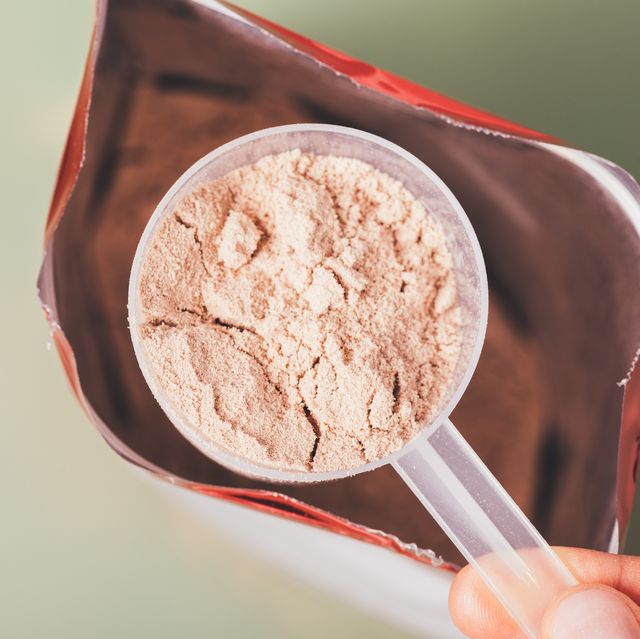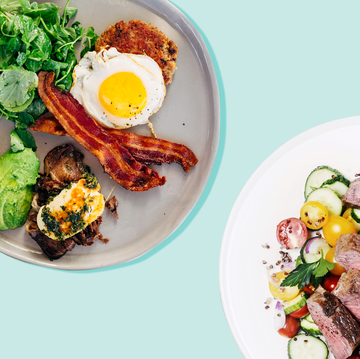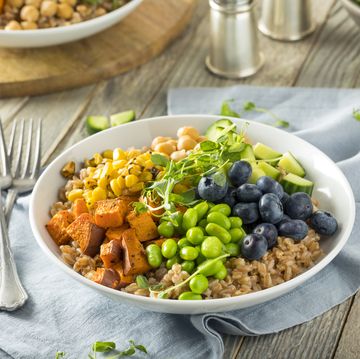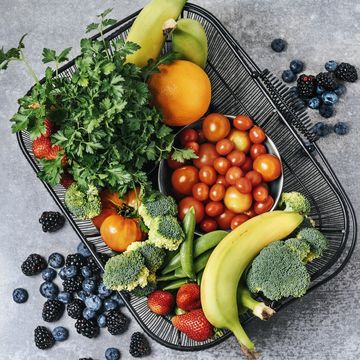Trendy diets come and go, but one questionable — and expensive — plan has been hanging around for several years now. Thought the Optavia diet was officially launched in 2017, it is actually a new version a weight-loss plan called Medifast, created in 1980. (The multilevel marketing company behind it was fined $3.7 million for false advertising in 2012.) But even with the advent of popular weight-loss drugs such Ozempic, the diet, which involves prepackaged foods, a few lean, green meals a day and personal coaching, still has its fans.
But what exactly does Optavia involve? When it comes to restrictions, nothing is technically off-limits on this diet. But in the Optimal Weight 5 & 1 Plan, the most popular of the diet's options, you eat only one whole-food meal per day; the rest of your 5 small meals come via "fuelings," packaged products you are required to buy from the web site or your personal coach. "A diet like this can feel extremely restrictive, which can create the desire to binge once off of it," says Marissa Meshulam, RD, of MPMNutrition in New York. "This all-or-nothing thinking with our diets does not lead to lasting success and can create large yo-yos not only in our weight, but also with how we feel."
Optavia is currently tied for #21 out of 24 in a ranking of diets by U.S. News & World Report, with 1.8 stars out of a possible 5; the main critique is that it is "not a very easy diet to follow," though it does score points for taking off the pounds quickly.
"In my experience, the calorie restriction on Optavia is far too extreme for most people — especially those who are choosing it as the first step in establishing a healthier eating pattern and lifestyle on the whole," said Jaclyn London, M.S., R.D., CDN, a New York City-based Registered Dietitian, consultant, and author of Dressing on the Side (and Other Diet Myths Debunked). "While accountability and community are key components to any behavior change program, behavior modification with restrictive eating patterns sets some of us up for disordered eating habits and restrict–binge–restrict tendencies."
Editor's note: Weight loss, health and body image are complex subjects — before deciding to go on a diet, we invite you to gain a broader perspective by reading our exploration into the hazards of diet culture.
Here's everything you need to know about Optavia before signing up:
What is the Optavia Diet?
Optavia is marketed as a weight-loss or maintenance plan that involves eating a mix of purchased, processed food created by the company — mainly shakes, bars, soups and crunchy snacks called "fuelings" — and homemade "lean and green" meals. One nice thing? You don't have to count carb, calories or points. Instead, you just add water to powdered food products or unwrap a bar as part of your plan, which can include up to six portion-controlled meals daily. This is a bonus for people who just don't want to have to put any effort to plan their meals, but the options are limited — though there are 60 fuelings to choose from, there is just a handful of what would be considered entrees, such as red bean chili and buttermilk cheddar mac. All fuelings contain added protein and a probiotic, and are around 100-110 calories. "These fuelings are extremely low calorie, which is not adequate," says Meshulem. "It's not rocket science that the most nourishing diet for all of us includes more produce, healthy proteins and fats and slow, nutrient-dense carbohydrate sources. By replacing the majority of our food with low-calorie processed foods, you may lose weight in the short term due to calorie deficit, but it is definitely not helping out your health in the long run."
The newest offering from the company is the Optavia Active plan, launched in September 2023. The new line of products, which they say were created to support muscle health, includes whey powder and an Essential Amino Acid (EAA) Blend. There is also a selection of new programs designed for individuals with diagnosed diabetes, as well as considerations for people over the age of 65. These programs slightly deviate from Optavia's signature 5&1 plan, and may be more customizable with input from your doctor.
Optavia also offers guidance from its own staff of diet coaches to help you learn their trademarked "Habits of Health" — these individuals are not required to obtain any medical accreditation to perform these services, to be clear.
The plan additionally recommends doing about 30 minutes of moderate-intensity exercise per day. Eventually, once your weight loss goals are met, the brand offers a secondary plan for weight loss maintenance that users can subscribe to.
Is the Optavia diet healthy?
In the Optavia diet, protein makes up 10–35% of your daily calories. It's also clear that the program relies on creating a calorie deficit in your dietary routine for initial weight loss results, which requires long-term maintenance. However, the processed, powdered variety of protein that's featured in programs like Optavia can lead to some less-than-pleasant side effects.
"A major 'red flag' here is the use of the word, 'fuelings,' which are designed to replace meals on Optavia. These protein powders often contain additives (including sugar alcohols, emulsifiers and texturizing agents) that can lead to unwanted GI side effects, making you far better off eating meals that include high protein foods that you enjoy vs. drinking them in the form of powder that may promote feelings of discomfort — particularly in the context of extreme calorie deficit," London said.
Plus, the FDA does not regulate dietary supplements like shakes and powders for safety and efficacy the same way it does for food. "It's essential you consult with your physician if you're considering starting this plan. Protein blends & powders may be contaminated with unwanted, undesirable ingredients or interact with a medication that you may already be taking — and there's also no way to guarantee that what you'll get in one batch is the same as what you'll receive in another one," London added.
More FAQs
What do you eat on Optavia?
At least half of any Optavia diet consists of its "fuelings," which include bars, shakes, cookies, cereal and some savory options, like soup and smashed potatoes. These processed foods often list soy protein or whey protein as the primary ingredient.
"Lean and green" meals fill out the rest of the diet, which requires you to shop and prepare via meal prep sessions on your own time. Those include:
- 5–7 ounces of cooked lean protein like fish, chicken, egg whites, turkey or soy
- 3 servings of non-starchy vegetables like lettuce, greens, celery or cucumbers
- Up to 2 servings of healthy fats like olive oil, olives or avocado
The Optavia advises eating six or seven times per day (about every two to three hours) depending on the chosen plan. The three available plans are:
How does Optavia help you lose weight?
Optavia heavily relies on intensely restricting calories to promote weight loss. Most "fuelings" hover around 100–110 calories each, meaning you could take in approximately 1,000 calories per day on this diet. Nutrition experts within the Good Housekeeping Institute have said that an intake of 1,200 calories is the bare minimum in order to avoid disordered or unhealthy eating, and going below this number can lead to extreme hunger, micronutrient deficiencies and other adverse side effects.
Despite Optavia's dramatic approach, U.S. News and World Report currently ranks it #2 in its list of Best Fast Weight-Loss Diets, tied with Atkins and Nutrisystem, and behind only the Keto diet. Notably, Optavia drops to #22 on the list of Best Diets for Healthy Eating, with many programs outperforming it.
London says there's a better approach to lasting weight loss: "'Eating meals and snacks that incorporate loads of produce, 100% whole grains, nuts, seeds, legumes, and pulses, low-fat dairy products, eggs, poultry, seafood, and lean beef plus some indulgences is the best way to lose weight sustainably for the long haul."
Meshulam points out that this extreme calorie restriction can have long-term effects that may be the opposite of what you hoped when starting the plan: "Since Optavia is so low calorie, it can lead us to a lot of muscle loss, versus fat loss, which can slow your metabolism down after the diet," she says. "A lot of people will look at a diet like this and see that it elicits quick weight loss and see that as a pro, whereas I like to look at long-term success on these things. Even if you lose 20 pounds in a few months, if you gain it back within the next year or two, the diet failed you and never really worked."
Is Optavia the same as Medifast?
Somewhat — Medifast Inc. is the parent company of Optavia. It also owns and operates the Medifast program you may remember from the '80s and '90s, which had doctors prescribing meals to their clients. Optavia uses similar foods with an identical macronutrient profile, but consumers can sign up for the plan themselves online.
How much does Optavia cost?
The essential 5&1 plan, which is Optavia's flagship offering, cost more than $375 per month, and that's not including what you'll spend on your "lean and green" meals (or what you cook at home). Here's what you can expect to pay for each program in 2024 (there is a discount for the first month's kit, these prices reflect the regular price):
- Optimal Weight 5 & 1 Plan: $511.50 for 154 servings
- Optimal Weight 5 & 1 ACTIVE Plan: $571.45 for 184 servings, including whey protein and the essential amino acids powder).
- Optimal Weight 4 & 2 ACTIVE Plan: $515.15 for 179 servings
In contrast, United States Department of Agriculture (USDA) estimates published in September 2022 suggest that a woman between the ages of 19-70 may spend upwards of $243 per month on groceries while still following a nutritious diet. It's true that you'll need to prepare most of your food, unlike Optavia — though, there are many other programs for you to consider that don't involve portion control.
The bottom line: "Eating real, nutrient-dense, delicious and health-promoting food that nourishes you is the only way to lose weight and keep it off long-term," London told Good Housekeeping.

Caroline is a writer and editor with almost a decade of experience. From 2015 to 2019, she held various editorial positions at Good Housekeeping, including as health editor, covering nutrition, fitness, wellness, and other lifestyle news. She's a graduate of the Medill School of Journalism and dreams of the day Northwestern will go back to the Rose Bowl.
Stefani (she/her) is a registered dietitian, a NASM-certified personal trainer and the director of the Good Housekeeping Institute Nutrition Lab, where she handles all nutrition-related content, testing and evaluation. She holds a bachelor’s degree in nutritional sciences from Pennsylvania State University and a master’s degree in clinical nutrition from NYU. She is also Good Housekeeping’s on-staff fitness and exercise expert. Stefani is dedicated to providing readers with evidence-based content to encourage informed food choices and healthy living. She is an avid CrossFitter and a passionate home cook who loves spending time with her big fit Greek family.












